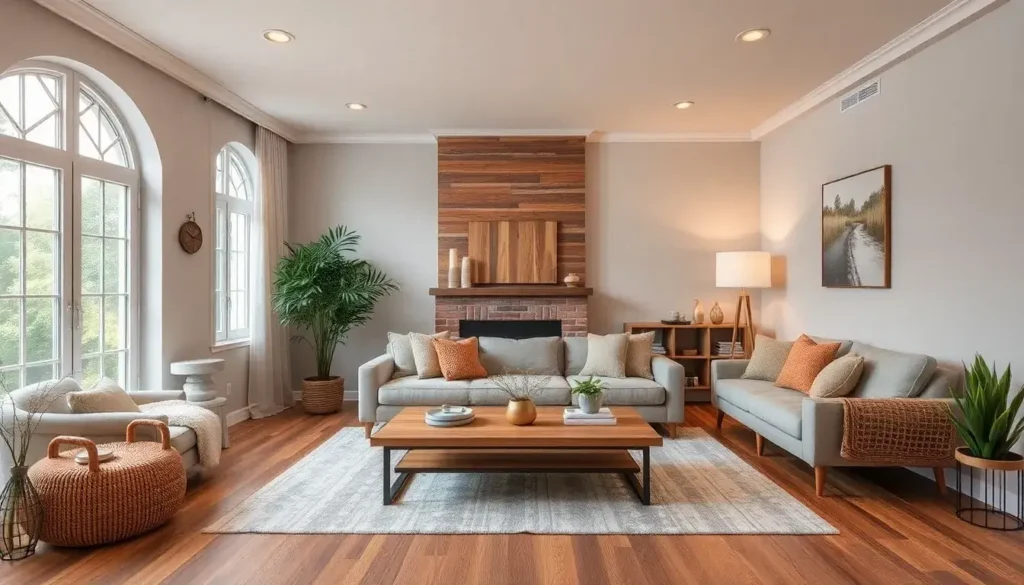Looking to breathe new life into your living room? You’re not alone. Many of us crave a space that’s warm, inviting, and stylish. That’s why I created this post! I wanted to gather more than 25 hardwood floor ideas that infuse your living room with both warmth and elegance.
If you’re a home decor enthusiast who loves creating cozy interiors or elegant spaces, this collection is for you. Whether you’re a seasoned designer or just starting your decorating journey, the right flooring can make all the difference. With sustainable options becoming more popular, there’s never been a better time to explore eco-friendly hardwood flooring choices that not only look good but are also kind to the planet.
In this post, you’ll discover a diverse range of hardwood flooring designs that will elevate your living room aesthetics. From rich walnut finishes to reclaimed wood that tells a story, each idea is crafted to inspire you. With various color schemes and styles, you’ll find the perfect fit for your unique taste. Plus, I’ll share tips on incorporating these flooring options into your living space, helping you create a cozy haven that feels just right. Let’s dive into the world of hardwood floors and transform your living room into a sanctuary of warmth and sophistication!
Key Takeaways
– Explore over 25 hardwood floor ideas that enhance the warmth and elegance of your living room.
– Discover eco-friendly options like bamboo and reclaimed wood for a sustainable interior.
– Learn how different wood tones, such as rich walnut or light oak, can dramatically change the ambiance of your space.
– Get practical tips on integrating various flooring styles with your existing home decor.
– Understand the importance of choosing the right flooring color scheme to complement your living room aesthetic.
1. Rich Walnut for a Luxurious Feel
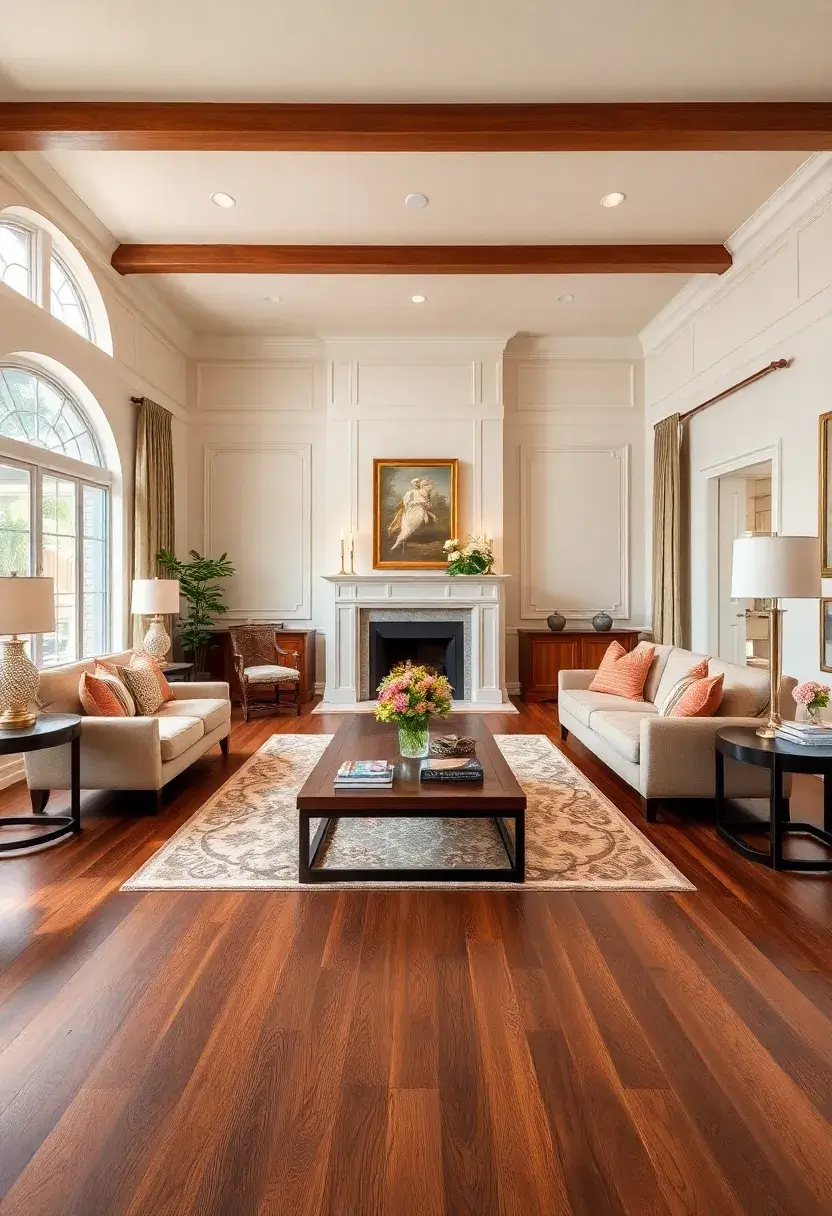
Rich walnut hardwood floors wrap your living room in warmth and elegance. The deep, dark hues radiate luxury and charm, especially when paired with soft, light-colored walls. Consider adding creamy or beige rugs to contrast with the wood’s richness. Pinterest showcases this trend with golden accents that beautifully complement walnut tones, creating a sophisticated atmosphere.
To make walnut flooring work for you, look for budget-friendly options like reclaimed walnut or laminate that mimics its beauty. Soft textiles like wool throws or velvet cushions can enhance your cozy vibe. This style fosters an inviting space, perfect for gatherings or quiet evenings at home.
• Add cream or beige rugs for contrast
• Incorporate gold or brass accents in decor
• Choose soft textiles like velvet for warmth
• Use vintage furniture to enhance luxury
With these tips, your living room can feel luxurious and cozy, inviting everyone to relax and enjoy.
Rich Walnut for a Luxurious Feel
Editor’s Choice
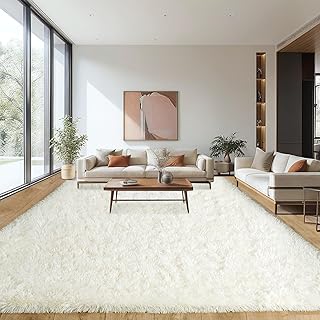
8×10 Area Rugs for Living Room Bedroom, Ultra Soft Fluffy Cream White La…
 Amazon$68.98
Amazon$68.98
Gold Sphere Decor, Metal Gold Starburst Tabletop Sculpture Decor, Modern…
 Amazon$18.99
Amazon$18.99
Exclusivo Mezcla Extra Large Fleece Throw Blanket for Couch, Sofa, 300GS…
 Amazon$9.99
Amazon$9.992. Light Oak for a Bright and Airy Space
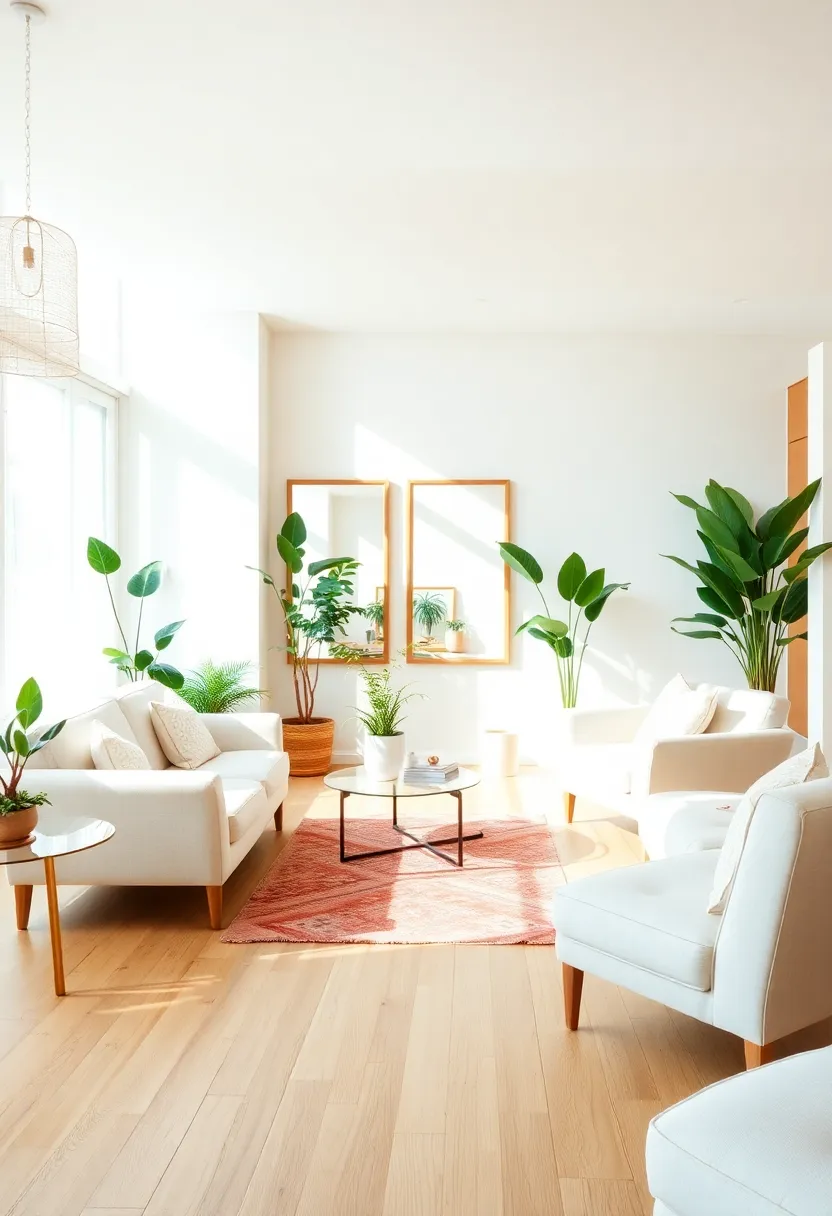
Light oak flooring can transform your living room into a bright oasis. Its natural hues reflect light, making the space feel larger and more open. Pair light oak with white or pastel furniture for a serene, airy vibe, often seen on popular design blogs.
For a stunning look, use large mirrors to bounce light around the room and create a sense of depth. Opt for soft, neutral-toned furniture to complement the floors while incorporating indoor plants for a splash of color. This approach not only brightens your space but also creates a fresh, welcoming atmosphere.
• Use large mirrors to reflect light
• Choose soft, neutral-toned furniture
• Incorporate indoor plants for color
• Keep window treatments minimal for natural light
Light oak floors can turn your living room into a breezy retreat filled with tranquility.
Light Oak for a Bright and Airy Space
Editor’s Choice

Vintage Arched Gold Mirror: 40″x30″ Large Gold Antique Wall Mounted Mirr…
 Amazon$149.99
Amazon$149.99
Tbfit 77.2″ W Linen Sofa Couch, Mid Century Modern Decor Loveseat Couche…
 Amazon$399.58
Amazon$399.58
Costa Farms Live Plants (Pack of 2), Easy to Grow Live Indoor Houseplant…
 Amazon$25.99
Amazon$25.993. Reclaimed Wood for Rustic Charm

Reclaimed wood floors bring rustic charm and character to your living space. Each plank tells a unique story, making your room feel warm and inviting. Pairing reclaimed wood with vintage furnishings creates a cozy, lived-in atmosphere, a favorite among home decor enthusiasts.
Highlight the unique textures of reclaimed wood by opting for warm lighting, like table lamps or wall sconces. Use organic shapes in your furniture to enhance the rustic feel. This style not only feels homey but also honors sustainability, making it a thoughtful choice.
• Highlight unique textures and imperfections
• Use organic shapes in furniture
• Incorporate warm lighting for charm
• Add vintage decor for character
Reclaimed wood can give your living room a cozy, rustic vibe, perfect for relaxing and connecting with family.
Reclaimed Wood for Rustic Charm
Editor’s Choice

EDISHINE Upgraded LED Table Lamp, Stepless Dimmable Bedside Lamp with 3 …
 Amazon$26.99
Amazon$26.99
Vintage Wall Sconces Set of 2 with Cute Green Tulip Glass Lampshade 180 …
 Amazon$68.39
Amazon$68.39
Modern Organic Shaped Coffee Table, Light Oak Wood, Curved Double Pedest…
 Amazon$199.99
Amazon$199.994. Espresso Finish for Modern Elegance
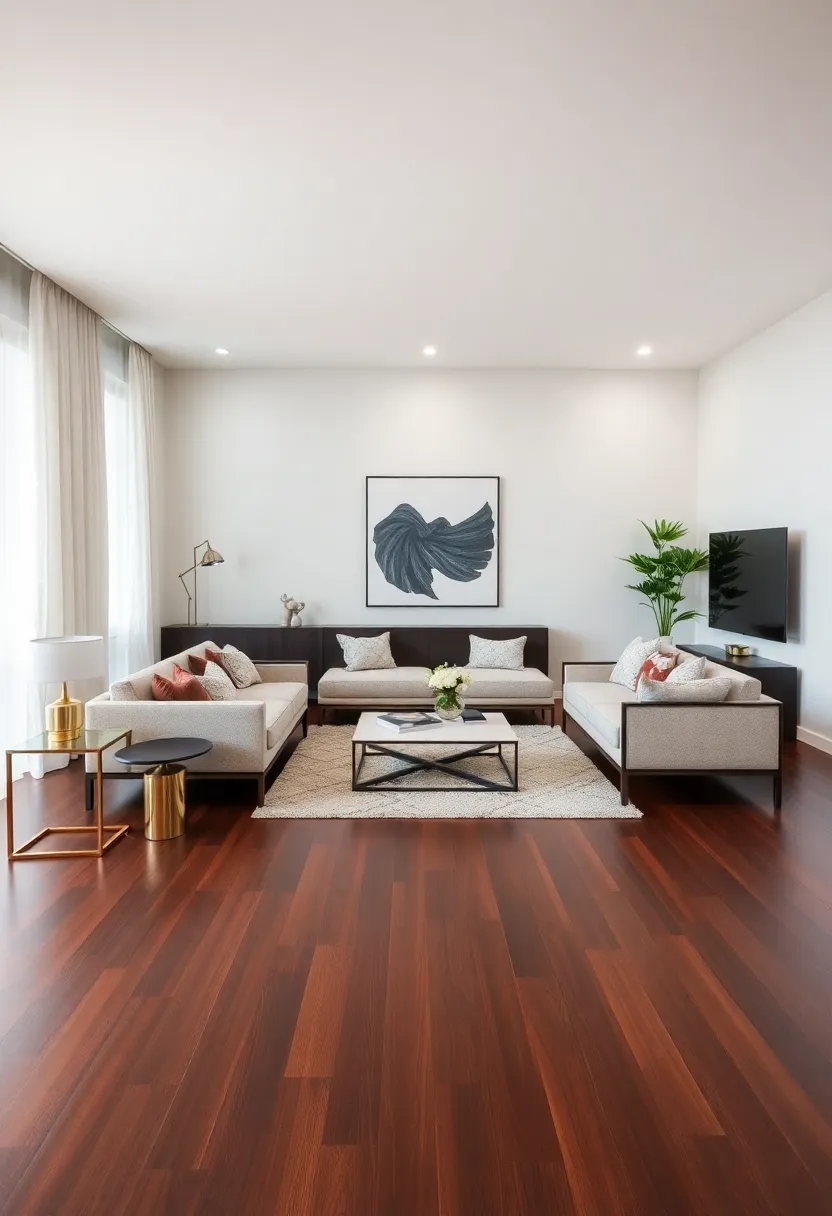
An espresso finish on hardwood floors adds a modern, sophisticated touch to your living room. The deep color contrasts beautifully with lighter walls and furniture, creating a striking visual effect. This style is trending, especially when paired with sleek, contemporary décor.
To elevate this look, choose furniture with clean lines and a minimalist design. Incorporate metallic accents like silver or chrome for added glam. Keep art pieces simple yet bold to maintain a balanced space. Espresso floors can create an upscale vibe while also feeling warm and inviting.
• Use clean-lined furniture for a sleek look
• Incorporate metallic accents for glam
• Choose simple, bold artwork for balance
• Keep decor minimal to enhance elegance
This style will help your living room feel both modern and cozy, ideal for entertaining or relaxing.
Espresso Finish for Modern Elegance
Editor’s Choice

Modern Glass Coffee Table, 32.3″D×25.6″W×15.8″H-Abstract Unique Mid Cent…
 Amazon$105.99
Amazon$105.99
Madison Park Signature Ansen Ceramic Handmade Vase Set Home Décor – Meta…
 Amazon$46.67
Amazon$46.67
Heiple Framed Bathroom Art Bathroom Wall Decor Farmhouse Home Decor Sets…
 Amazon$22.99
Amazon$22.995. Grey Hardwood for Contemporary Style
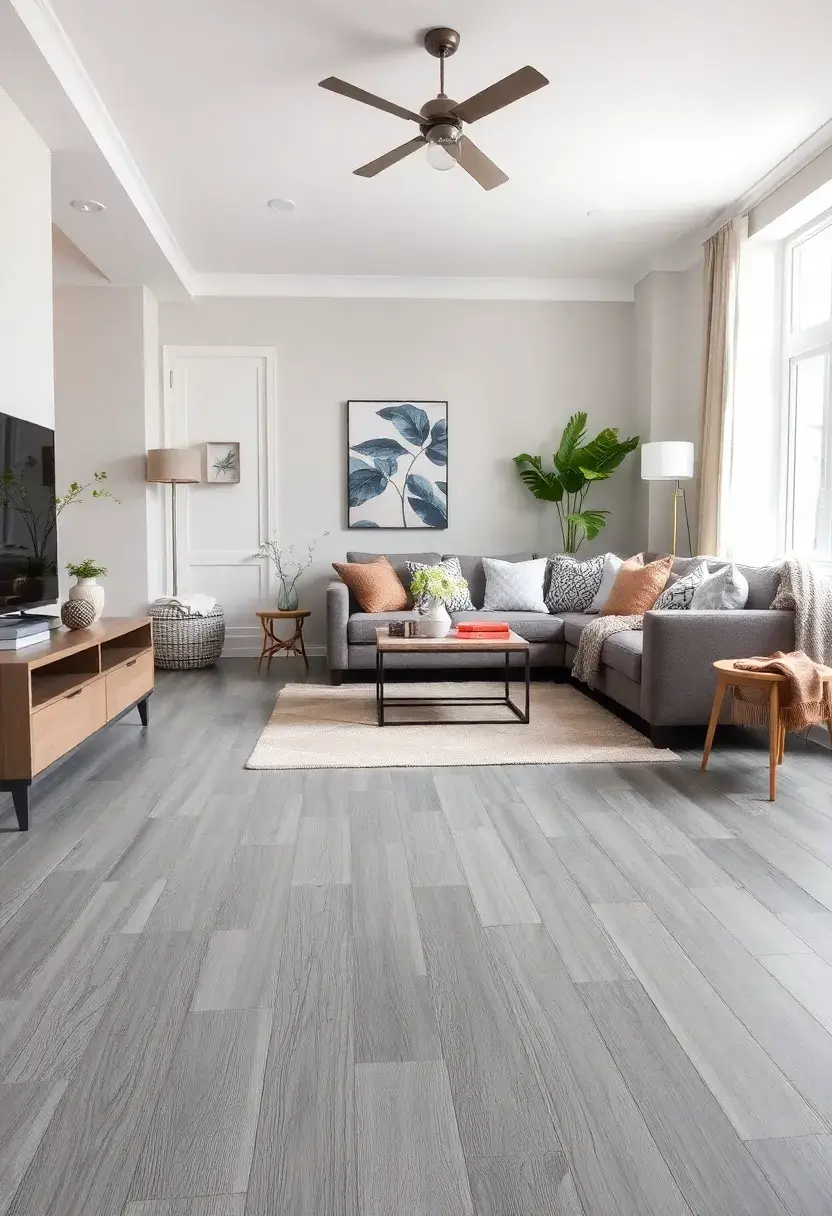
Grey hardwood floors are a trendy choice for contemporary homes. Their neutral tones blend seamlessly with both rustic and modern decor, making them incredibly versatile. Style your grey floors with bright, bold colors for a striking contrast that catches the eye.
To soften the starkness of grey, incorporate plush rugs and cozy throws. Use warm wood or metal accents in your furniture to create a balanced look. This approach allows for endless styling possibilities while maintaining a chic atmosphere.
• Pair with bold colors for contrast
• Incorporate plush rugs for softness
• Use warm wood or metal accents
• Add cozy throws for warmth
Grey hardwood can provide a sleek and stylish foundation for your living room, making it feel modern and inviting.
Grey Hardwood for Contemporary Style
Editor’s Choice

Large Shag Area Rugs 5 x 8, Tie-Dyed Plush Fuzzy Rugs for Living Room, U…
 Amazon$29.99
Amazon$29.99
BOURINA Beige Throw Blanket 50×60 Inches Throw Textured Solid Soft Sofa …
 Amazon$18.98
Amazon$18.98
Powell Tarkin Round Natural Wood Turned Spindle Pedestal Side Accent Table
 Amazon$46.39
Amazon$46.396. Blonde Wood for a Scandinavian Touch
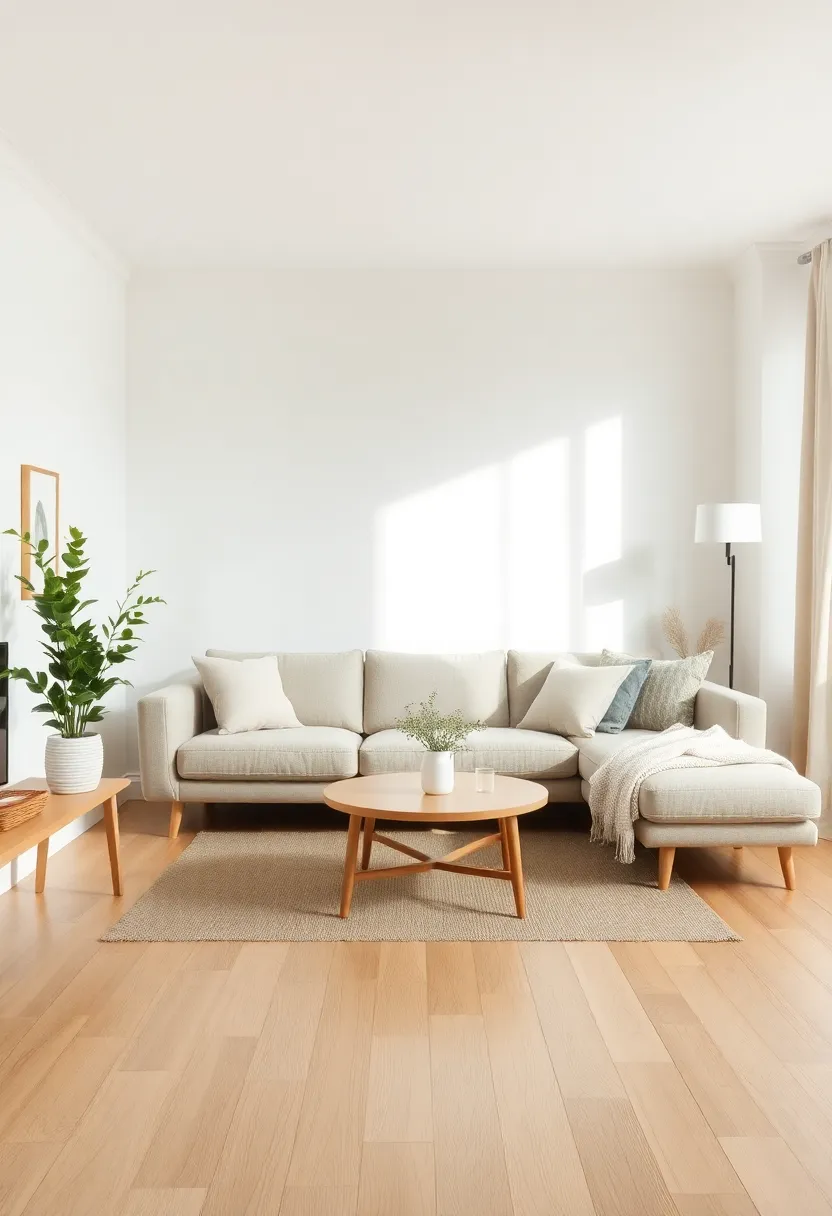
Blonde wood floors are essential for achieving that Scandinavian design aesthetic. Their light tones create a clean, crisp look that reflects the simplicity and beauty of this style. Pair blonde floors with white or light pastel decor for a fresh, airy feel, a favorite among design lovers.
To enhance this aesthetic, keep window treatments minimal to maximize natural light. Add textures with knitted throws or woven baskets for warmth and comfort. This approach promotes tranquility and serenity in your living space.
• Use white or light pastel decor for harmony
• Emphasize natural light with minimal window treatments
• Add textures like knitted throws
• Incorporate woven baskets for warmth
Blonde wood floors can create a calm and peaceful environment in your living room, perfect for relaxation.
Blonde Wood for a Scandinavian Touch
Editor’s Choice

L’AGRATY Chunky Knit Blanket Throw,Soft Chenille Yarn Throw 50×60,Handma…
 Amazon$31.34
Amazon$31.34
Goodpick Woven Storage Basket, Cotton Rope Basket for Dog Toys, Books, S…
 Amazon$14.39
Amazon$14.39
8Pcs 18 x 18 Inch Decorative Throw Pillow Covers Pastel Mix Color Pillow…
 Amazon$19.99
Amazon$19.997. Bamboo Flooring for Eco-Friendly Living
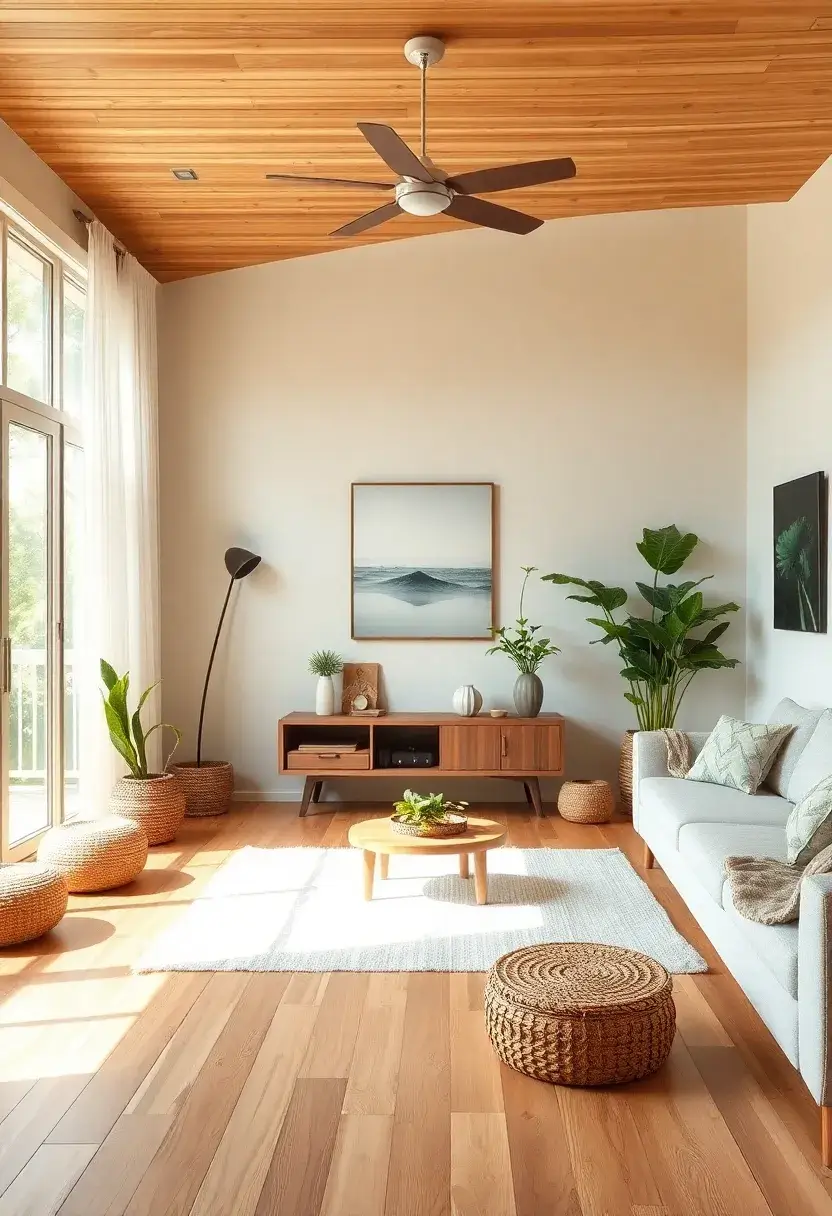
Bamboo flooring is a sustainable and stylish choice that brings natural beauty to your living room. Its unique grain patterns suit various design styles while being durable and eco-friendly. This flooring option is becoming increasingly popular among environmentally conscious homeowners.
To style bamboo floors, choose natural color palettes that highlight the wood’s unique grain. Incorporate sustainable decor elements, like recycled materials, to enhance the eco-friendly theme. Adding houseplants can promote a healthy environment while also adding color.
• Opt for natural color palettes to highlight grain
• Use sustainable decor for a cohesive theme
• Incorporate houseplants for freshness
• Choose recycled materials to enhance eco-friendliness
Bamboo flooring can transform your living room into a beautiful, sustainable sanctuary, making it a perfect choice for eco-conscious living.
Bamboo Flooring for Eco-Friendly Living
Editor’s Choice


Yuoyar Coasters, Wooden Tree-Shaped Sapeli Wood Drink Coasters Set for C…
 Amazon$7.99
Amazon$7.99
Easy to Grow Houseplants (6PK), Live House Plants in Plant Containers, G…
 Amazon$25.11
Amazon$25.118. Dark Mahogany for Opulent Charm

Dark mahogany flooring can create an opulent atmosphere in your living room. Its deep, rich hues evoke warmth and luxury, making it a stunning focal point. Pair mahogany floors with deep jewel tones in your furnishings for a look that feels both elegant and inviting.
To enhance the luxurious vibe, incorporate plush rugs that add texture and warmth. Vintage or antique decor pieces can elevate the overall aesthetic, creating a sophisticated yet cozy environment. This style can make your living space truly stand out.
• Choose deep jewel tones in furnishings
• Incorporate plush rugs for added warmth
• Use vintage decor for elegance
• Balance with cozy elements for comfort
Mahogany floors can serve as a beautiful centerpiece, enhancing both elegance and coziness in your living room.
Dark Mahogany for Opulent Charm
Editor’s Choice

SAFAVIEH Area Rug 8×10 – Hudson Shag Collection – Large – Ivory & Beige,…
 Amazon$262.79
Amazon$262.79
Dosmix Retro Bluetooth Speaker, Vintage Decor, Mini Wireless Bluetooth S…
 Amazon$13.99
Amazon$13.99
18×18 Pillow Cover Set of 4 Soft Gem Tone Velvet Decorative Pillow Cover…
 Amazon$26.98
Amazon$26.989. Rustic Hickory for a Homely Feel
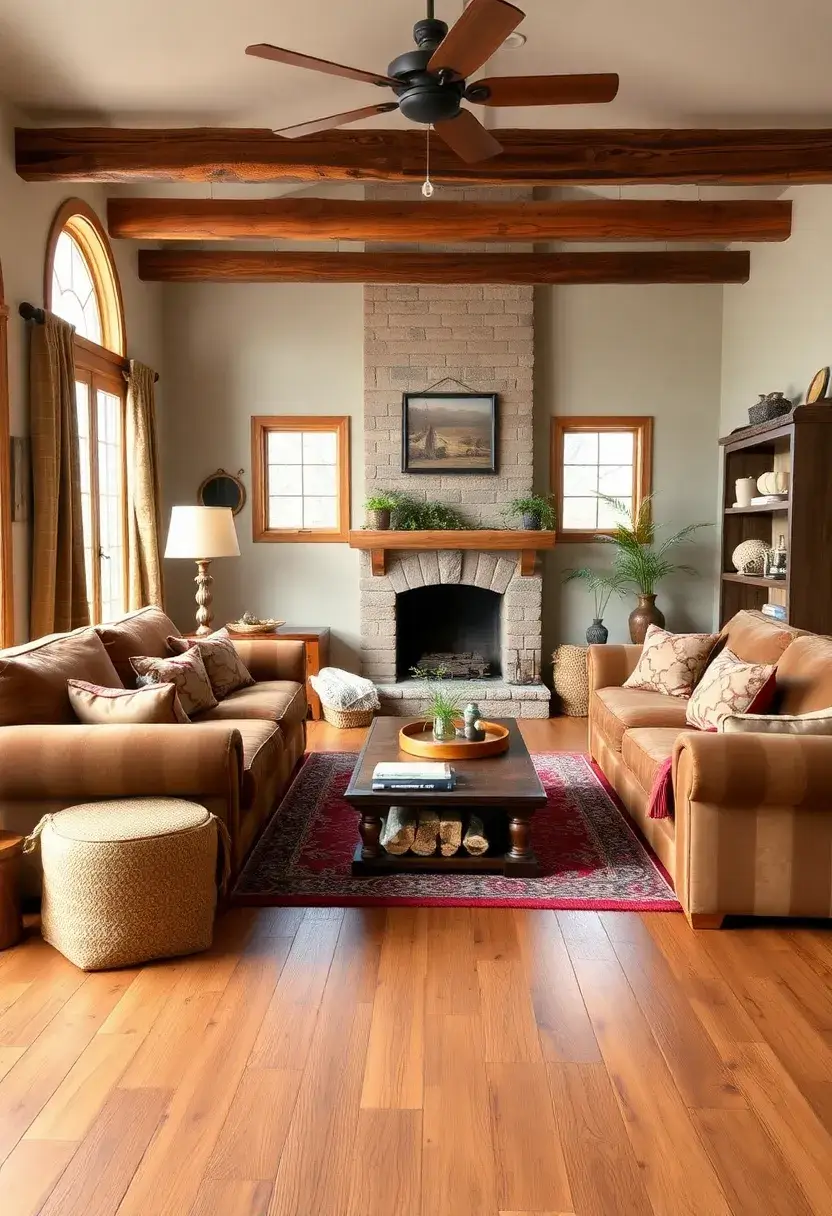
Hickory hardwood floors add rustic charm and a homely atmosphere to your living room. Their natural variations in color and grain patterns provide warmth and character. Pairing hickory floors with oversized, comfy furniture can create a laid-back, inviting space for family gatherings.
Use warm earth tones in your decor to complement the hickory’s natural beauty. Incorporate personal touches, like family photos or handmade crafts, to enhance the homely feel. This style encourages comfort and connection with loved ones.
• Combine with oversized furniture for comfort
• Use warm earth tones in decor
• Add personal touches for homeliness
• Incorporate cozy textiles for warmth
Hickory flooring can create a welcoming living room, blending comfort and style beautifully.
Rustic Hickory for a Homely Feel
Editor’s Choice

ROWHY Oversized Modular Sectional Sofa with Movable Ottoman, 112 Inch 4 …
 Amazon$449.99
Amazon$449.99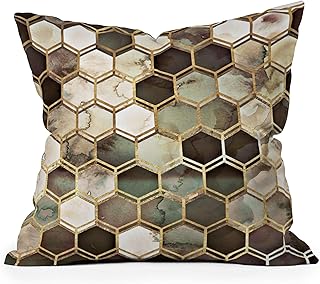
Society6 Home Monika Strigel-Decorative Accent Couch or Bed Throw Pillow…
 Amazon$40.50
Amazon$40.50
Bedsure GentleSoft White Throw Blanket for Couch – Cozy Blanket for Wome…
 Amazon$12.34
Amazon$12.3410. Ash Wood for an Industrial Look
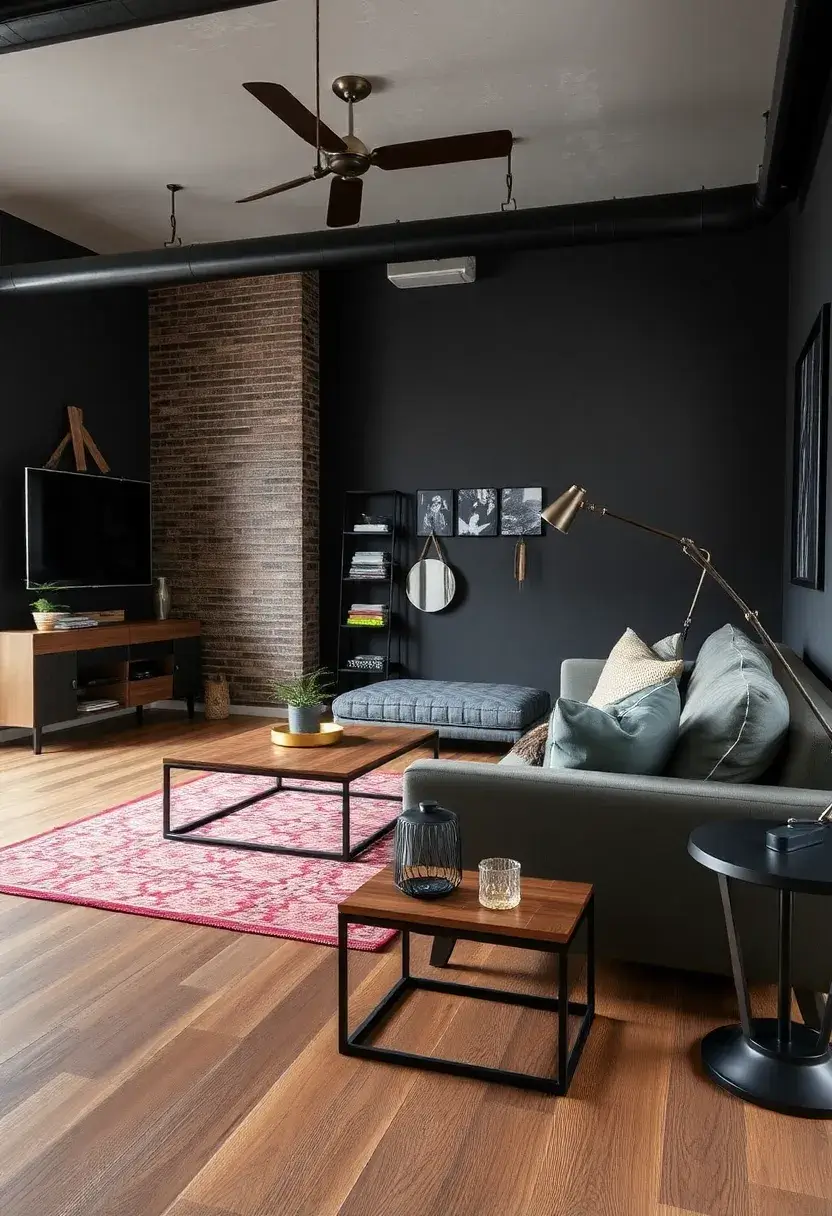
If you love the industrial style, ash hardwood flooring provides an excellent backdrop for your living room. Its light, neutral tones balance the raw, edgy elements often found in industrial decor. This flooring choice suits modern, urban aesthetics perfectly.
To enhance the industrial look, combine ash floors with metal and concrete accents in your furniture. Dark, moody colors in wall decor can create striking contrasts. Soft lighting can add warmth to the hard edges, making the space inviting.
• Combine with metal and concrete accents
• Use dark colors for wall decor
• Incorporate soft lighting for warmth
• Choose simple furniture to highlight floors
Ash flooring can create a stylish, industrial chic living room where comfort meets contemporary design.
Ash Wood for an Industrial Look
Editor’s Choice

Rectangle Coffee Tables for Living Room, Wood Rectangular Coffee Table, …
 Amazon$108.00
Amazon$108.00
Kante 21.7″ H Natural Concrete Tall Planter, Large Outdoor Indoor Decora…
 Amazon$106.99
Amazon$106.99
luckystyle Dimmable Floor Standing Tall Lamp, 12W Led Bulb with Lampshad…
 Amazon$29.99
Amazon$29.9911. Cherry Wood for Timeless Elegance
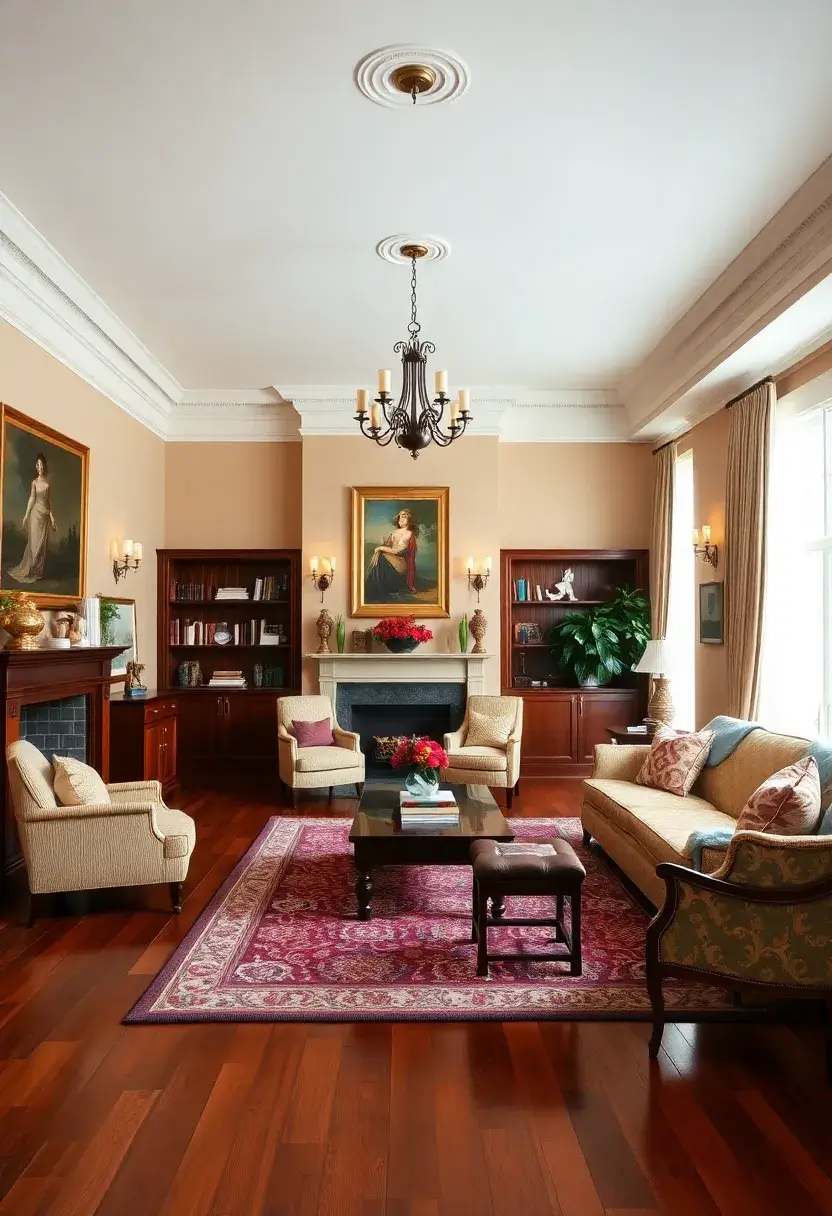
Cherry wood flooring is known for its classic elegance and warm reddish tones. This flooring choice can enhance any living room, adding a touch of sophistication. To style cherry floors effectively, use warm colors in your furnishings to create a cohesive look.
Incorporate elegant light fixtures that reflect the wood’s rich hues and add classic art pieces to elevate the refined atmosphere. This approach fosters a sophisticated yet cozy environment, perfect for entertaining guests.
• Use warm colors in furnishings
• Incorporate elegant light fixtures for reflection
• Add classic art pieces for refinement
• Keep decor cohesive for harmony
Cherry wood can create a timeless living room space that feels both elegant and welcoming.
Did you know cherry wood floors deepen with age, shifting from warm reddish tones to rich amber? It’s a timeless pick among hardwood floor ideas for living room. Pair with warm furnishings and soft lighting; elegant fixtures reflect the wood’s hue, elevating the space.
Cherry Wood for Timeless Elegance
Editor’s Choice

MIULEE Fall Decorative Throw Pillow Covers 18×18 Inch Set of 4, Vibrant …
 Amazon$17.99
Amazon$17.99
3-Piece Pendant Lights Kitchen Island, Elegant Modern Island Lights for …
 Amazon$69.99
Amazon$69.99
MINI ZOZI Famous Art Prints And Posters 16PCS Paintings Fine Art Impress…
 Amazon$18.95
Amazon$18.9512. Natural Stained Finish for Versatility
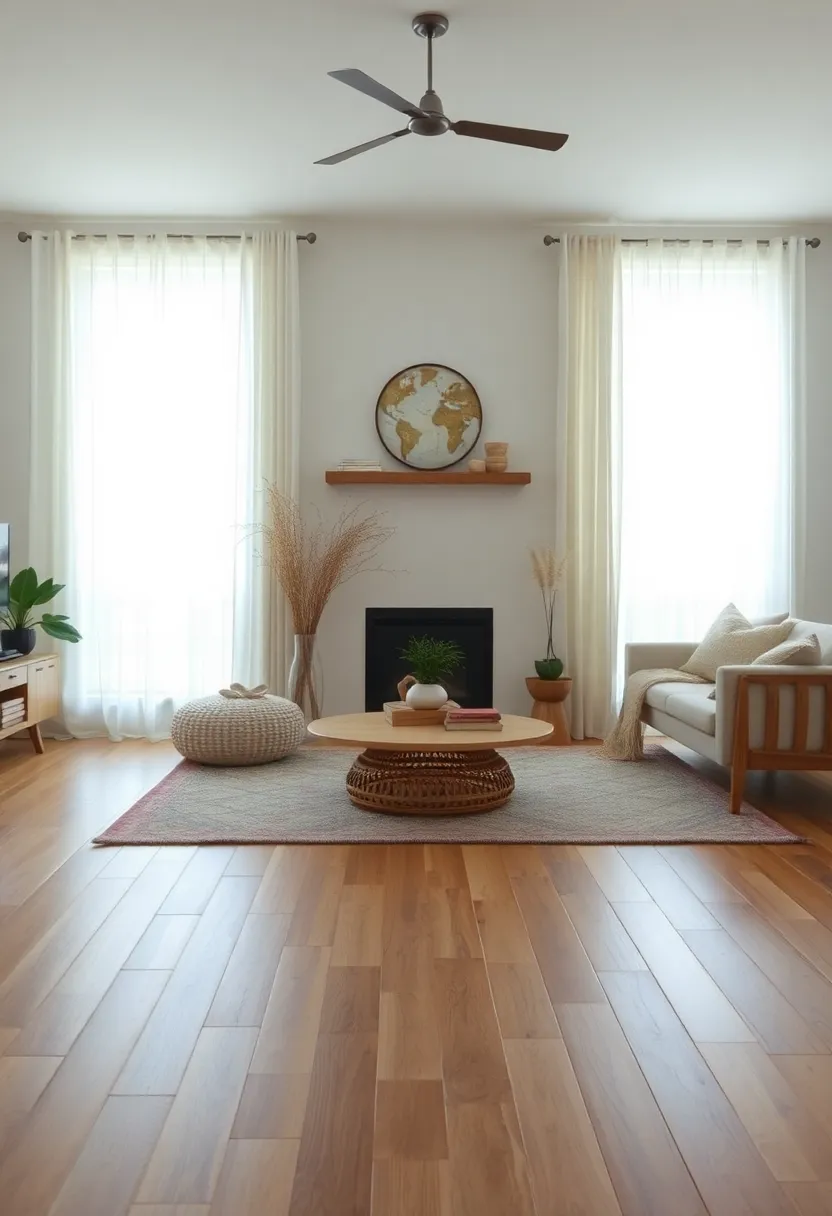
Choosing a natural stained finish on hardwood floors can create a beautiful organic look. This finish highlights the wood’s natural grain while offering versatility for various decor styles. To make the most of natural stained floors, opt for muted decor colors that allow the wood to shine.
Use organic materials like wool and cotton in your furnishings to enhance the earthy feel. Incorporating natural elements, such as wood or stone, in your furniture helps maintain consistency in the design. This approach creates a serene atmosphere in your living space.
• Choose muted decor colors for harmony
• Use organic materials for a natural feel
• Incorporate natural elements in furniture
• Keep decor minimal to let flooring shine
Natural finishes can create a calming essence in your living room, making it a beautiful retreat.
Natural Stained Finish for Versatility
Editor’s Choice

SAFAVIEH Blossom Collection Area Rug – 8′ x 10′, Green & Multi, Handmade…
 Amazon$307.49
Amazon$307.49
Foamily Throw Pillow Inserts 100% Cotton 4 Pack 18×18 Pillow Inserts for…
 Amazon$24.99
Amazon$24.99
LITTLE TREE Farmhouse Coffee Table, 47 Inches Wooden Rectangular Accent …
 Amazon$139.99
Amazon$139.9913. Cross-Laminated Timber for Modern Sustainability
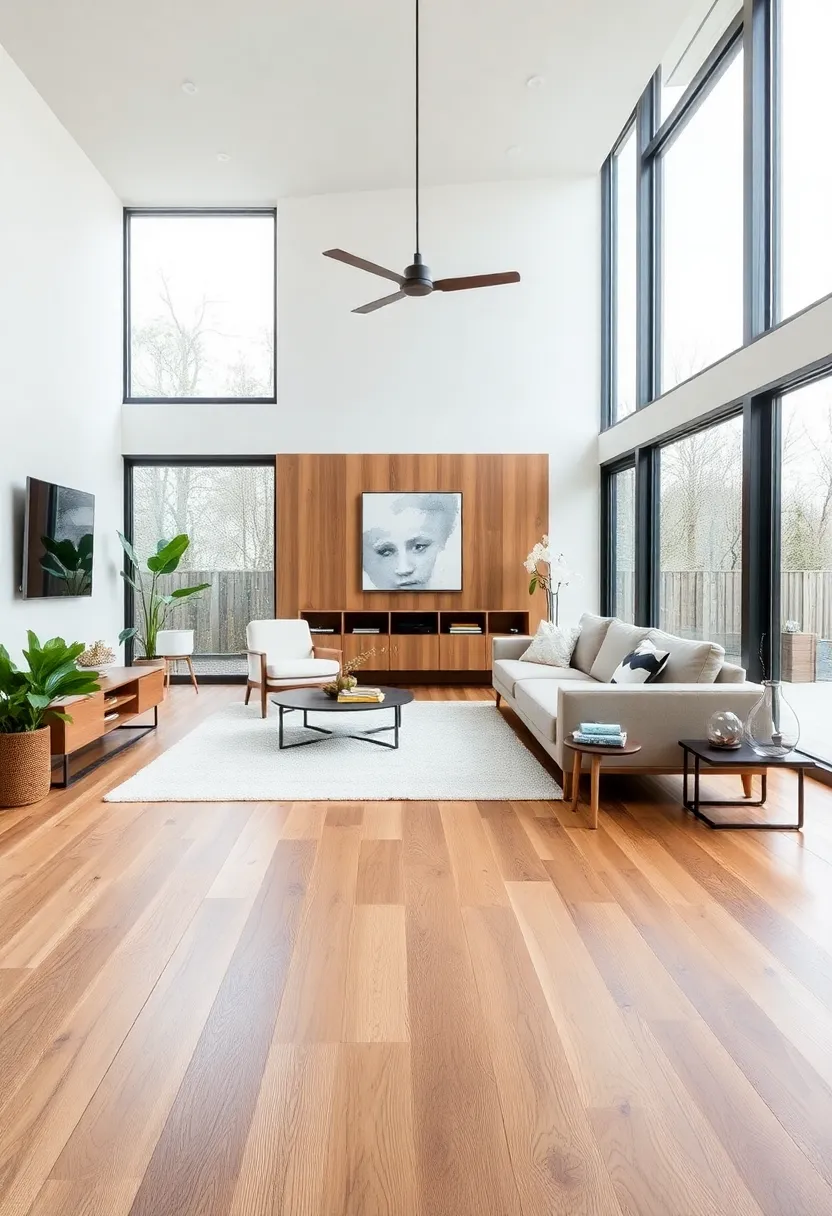
Cross-laminated timber (CLT) is a modern flooring choice that blends stylish design with sustainability. Made from layers of timber glued together, CLT offers strong and attractive flooring options. To style with CLT, keep your decor minimalist to highlight the beauty of the wood.
Use bright colors in your furnishings to create a lively contrast against the natural tones of the timber. Incorporating large windows allows for maximum natural light, enhancing the space’s openness. This style is perfect for those who want a chic, eco-friendly living room.
• Keep decor minimalist for emphasis
• Use bright colors for contrast
• Incorporate large windows for natural light
• Choose sustainable furnishings for consistency
CLT flooring can create a stylish living room that is both modern and environmentally friendly.
Cross-Laminated Timber for Modern Sustainability
Editor’s Choice

CAMILSON Easy Jute Rug 8×10, Indoor Outdoor Natural Color Fiber Area Rug…
 Amazon$179.90
Amazon$179.90
Modern Glass Coffee Table, 32.3″D×25.6″W×15.8″H-Abstract Unique Mid Cent…
 Amazon$105.99
Amazon$105.99
Utopia Bedding Throw Pillows (Set of 4, White), 18 x 18 Inches Pillows f…
 Amazon$23.64
Amazon$23.6414. Distressed Wood for a Vintage Vibe
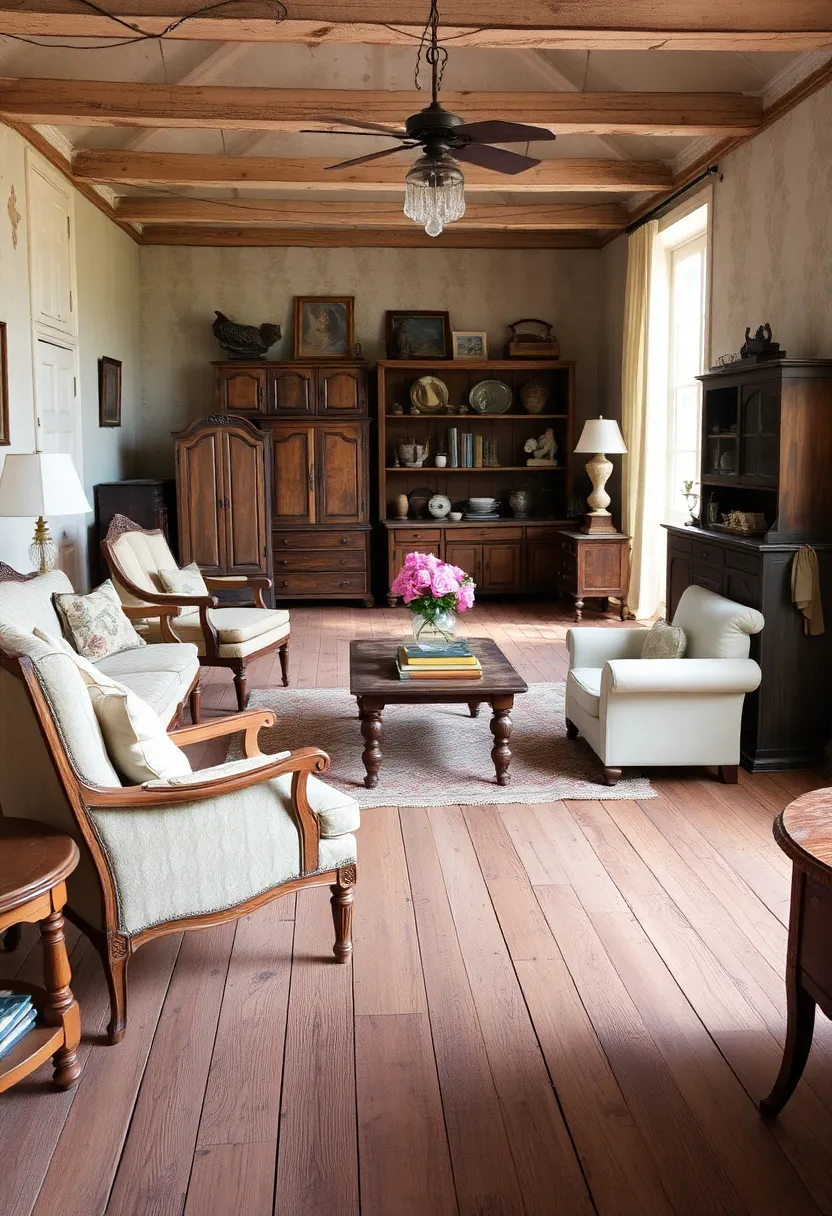
Distressed wood flooring adds a vintage feel and character to your living room. With intentional imperfections, this flooring option tells a story and creates a sense of history. To style distressed wood, combine it with vintage-inspired furniture for a cohesive look that feels warm and inviting.
Use warm, muted colors in your textiles to enhance the old-world charm. Adding cozy elements like woven blankets or rustic decor pieces can further enhance the welcoming atmosphere. This style is perfect for those who appreciate nostalgia and character in their space.
• Combine with vintage furniture for cohesion
• Use warm colors in textiles
• Add cozy elements like woven blankets
• Incorporate rustic decor for character
Distressed wood can create a living room that feels both inviting and full of stories.
Distressed Wood for a Vintage Vibe
Editor’s Choice

L’AGRATY Chunky Knit Blanket Throw,Soft Chenille Yarn Throw 50×60,Handma…
 Amazon$31.34
Amazon$31.34
Furnulem 4 Drawer Dresser, Vertical Nightstand for Kids, Adult, Fabric C…
 Amazon$39.99
Amazon$39.9915. Cork Flooring for Unique Comfort
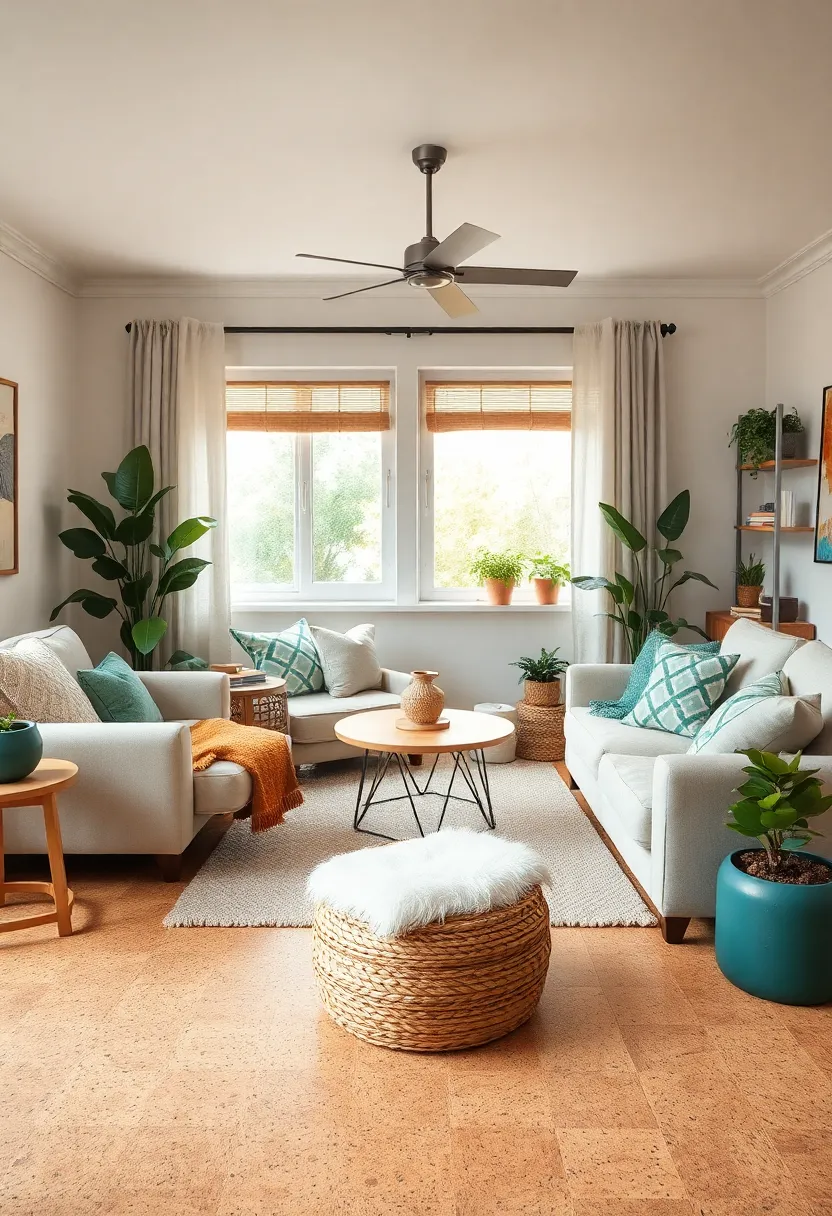
Cork flooring is an eco-friendly option that brings uniqueness and comfort to your living room. Its soft texture and warm tones create a cozy atmosphere while being sustainable. To style cork flooring, use soft, plush furnishings for maximum comfort that invites relaxation.
Incorporate bright colors in your decor to add a lively touch to the space. Embracing natural elements, like wood accents, helps create a harmonious look that blends style with comfort. This flooring choice is practical and stylish, perfect for any living area.
• Use soft, plush furnishings for comfort
• Incorporate bright colors in decor for liveliness
• Embrace natural elements for harmony
• Choose eco-friendly materials for consistency
Cork flooring can enhance your living room, making it feel cozy and welcoming while being kind to the planet.
Cork Flooring for Unique Comfort
Editor’s Choice
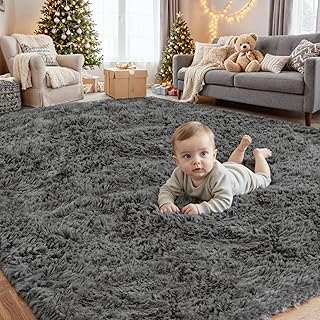
8×10 Area Rugs for Living Room: Ultra Soft Fluffy Shag Gray Rugs for Bed…
 Amazon$44.99
Amazon$44.99
Utopia Bedding Throw Pillows Insert (Pack of 2, White) – 18 x 18 Inches …
 Amazon$17.49
Amazon$17.49
WELLAND Irregular Cedar Wood Sculpture 8.75″ W x 1.75″ D x 17.75″ H Natu…
 Amazon$29.89
Amazon$29.8916. Charred Wood for a Bold Statement
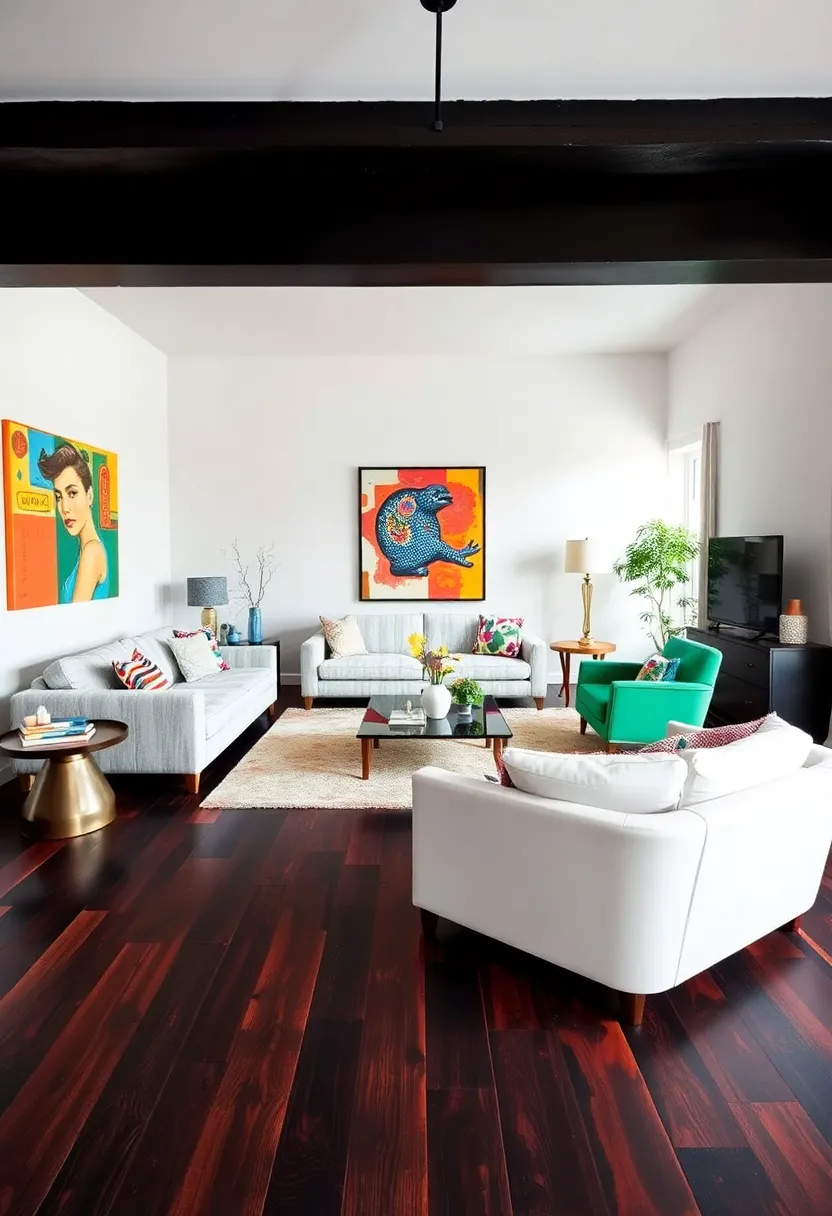
Charred wood flooring is a standout choice that makes a bold statement in any living room. Its intense, dark finish adds depth and drama, perfect for those wanting to break from traditional styles. To style charred wood, pair it with bright furnishings for a striking contrast that catches the eye.
Use artwork with color to enhance the boldness of the floor while incorporating ambient lighting to soften the strong tones. This approach creates a modern, artistic atmosphere that feels inviting and unique.
• Pair with bright furnishings for contrast
• Use colorful artwork to enhance boldness
• Incorporate ambient lighting for warmth
• Keep decor minimal to let flooring shine
Charred wood floors can transform your living room into a modern work of art, making it a unique space.
Charred Wood for a Bold Statement
Editor’s Choice

8Pcs 18 x 18 Inch Decorative Throw Pillow Covers Rainbow Mix Color Pillo…
 Amazon$19.99
Amazon$19.99
Boho Colorful Mountain Wall Art Set of 3, Abstract Watercolor Landscape …
 Amazon$37.99
Amazon$37.99
EDISHINE LED Corner Lamp, Set of 2 Minimalist Dimmable Tall Light with R…
 Amazon$79.99
Amazon$79.9917. Whitewashed Wood for a Coastal Feel
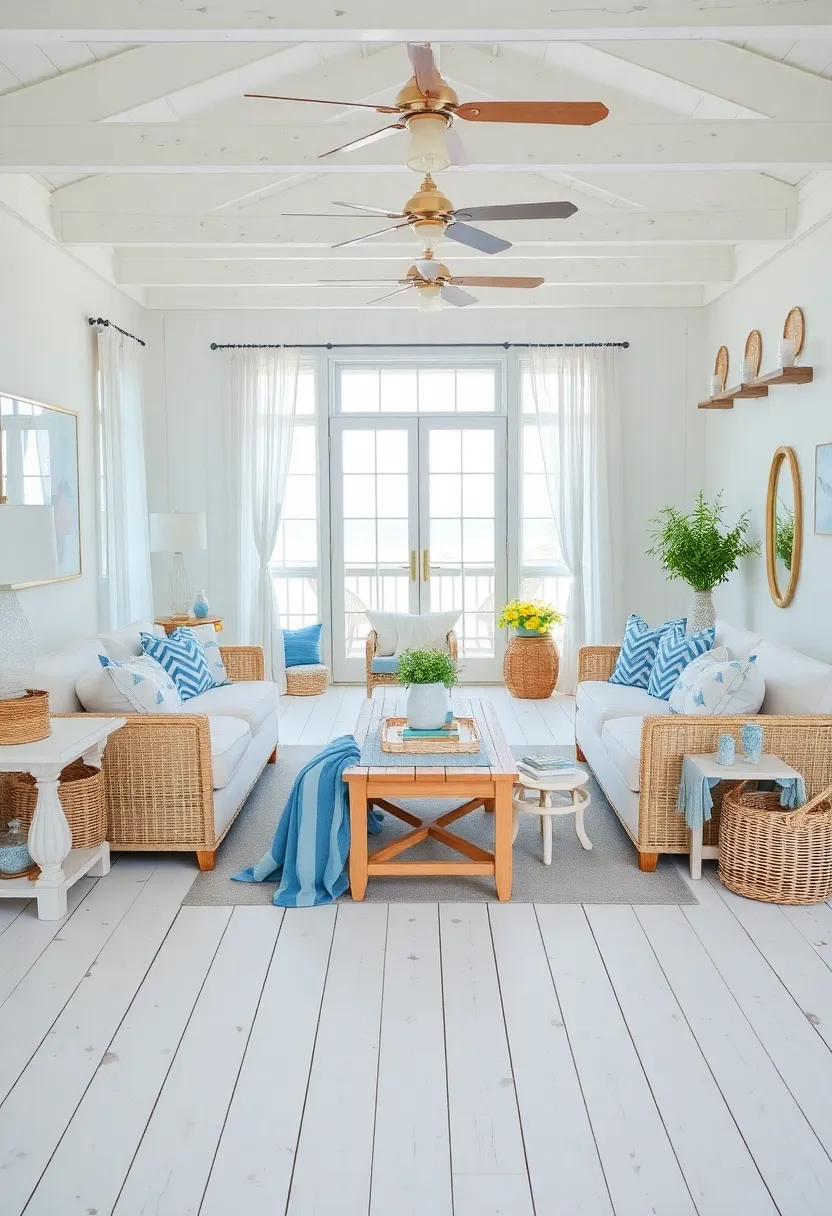
Whitewashed wood flooring evokes a relaxed, coastal vibe perfect for beach-style living rooms. Its light tones brighten any space, creating a serene environment that feels refreshing. To style whitewashed wood, use nautical-themed decor to enhance the coastal feel of your space.
Incorporate soft blues and whites in textiles for a cohesive look that highlights the flooring. Use natural fibers like jute or sisal for rugs to add texture and warmth. This approach creates a peaceful atmosphere, ideal for a calming retreat.
• Use nautical-themed decor to enhance coastal vibes
• Incorporate soft blues and whites in textiles
• Use natural fibers for rugs
• Keep decor minimal for serenity
Whitewashed wood can create a tranquil living room that feels like a seaside getaway.
Fun fact: whitewashed hardwood reflects more natural light, boosting room brightness by up to 60%. In living rooms, pairing soft blues and white textiles makes hardwood floor ideas for living room feel breezy and coastal. It’s practical and instantly calming.
Whitewashed Wood for a Coastal Feel
Editor’s Choice

Wooden Sea Birds Statues Coastal Decor, White Seagull Statues for Nautic…
 Amazon$24.93
Amazon$24.93
CAMILSON Easy Jute Rug 8×10, Indoor Outdoor Natural Color Fiber Area Rug…
 Amazon$179.90
Amazon$179.90
Nanspring White Linen Curtains 84 inches Long for Bedroom Back Tab Light…
 Amazon$17.98
Amazon$17.9818. Multi-Width Planks for Visual Interest
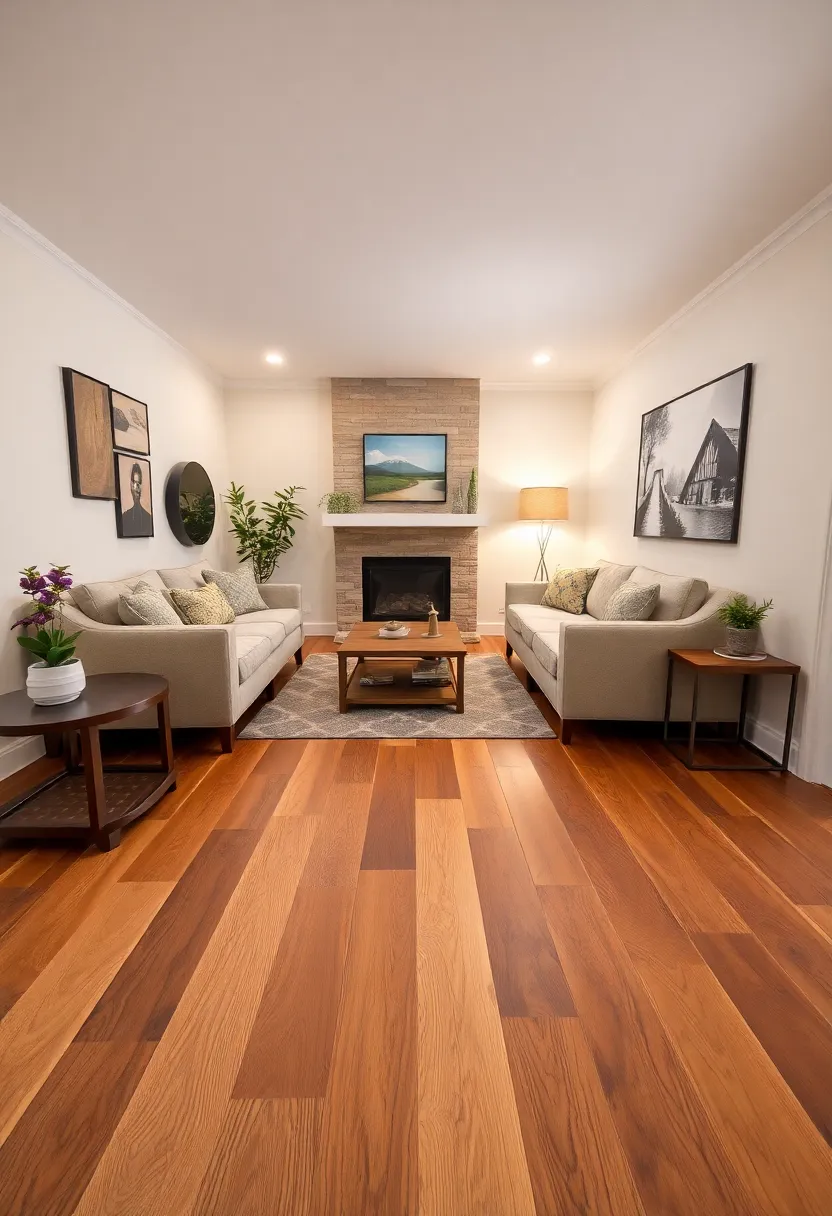
Using multi-width planks adds dynamic visual interest to hardwood floors. This unique design choice breaks traditional patterns and can make your living room stand out. To style multi-width planks, choose rugs that complement the varied patterns without overwhelming them.
Use simple furniture to highlight the unique flooring and keep wall colors neutral to let the floor take center stage. This approach creates a modern and engaging space that feels fresh and exciting.
• Choose complementary rugs for balance
• Use simple furniture to highlight floors
• Keep wall colors neutral for focus
• Incorporate minimalist decor for clarity
Multi-width flooring can transform your living space, making it feel lively and stylish.
Multi-Width Planks for Visual Interest
Editor’s Choice
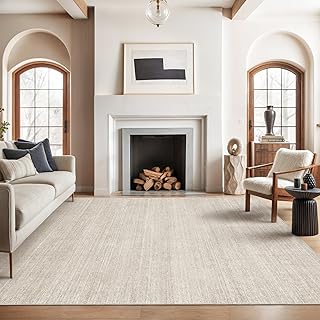
Valenrug Washable Rugs 8×10 – Stain Resistant 8×10 Area Rugs for Living …
 Amazon$119.99
Amazon$119.99
Modern Glass Coffee Table, 32.3″D×25.6″W×15.8″H-Abstract Unique Mid Cent…
 Amazon$105.99
Amazon$105.99
EVOLVE Paint & Primer: Environment-friendly, Low Sheen with One-coat Cov…
 Amazon$28.04
Amazon$28.0419. Parquet Flooring for Geometric Flair
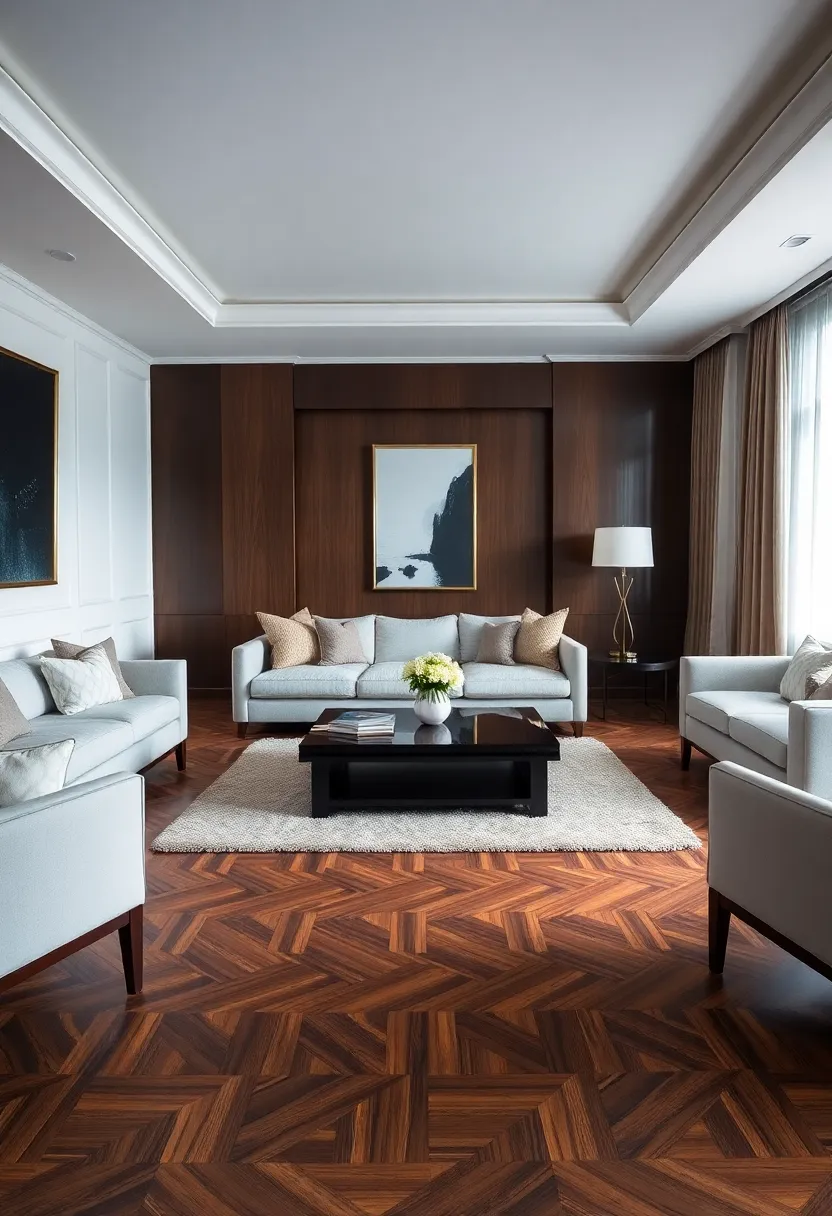
Parquet flooring brings classic elegance with its intricate geometric patterns. This flooring choice adds a sophisticated touch to your living room, making it feel like a work of art. To complement parquet floors, use furniture with clean lines to avoid competing with the patterns.
Stick to solid colors in textiles to enhance the visual impact of the flooring. Incorporate statement pieces, like a bold coffee table, to create balance and interest in the space. This approach elevates your living room into a stunning visual statement.
• Use clean-lined furniture for cohesion
• Stick to solid colors in textiles
• Incorporate statement pieces for balance
• Keep decor minimal to let flooring shine
Parquet flooring can turn your living room into an elegant showcase of artistry and style.
Parquet Flooring for Geometric Flair
Editor’s Choice

Glass Coffee Table Modern Center Table,Minimalist Coffee Table Sofa Side…
 Amazon$59.99
Amazon$59.99
Preboun 8 Pcs 18 x 18 Inch Fresh Colors Decorative Throw Pillow Covers M…
 Amazon$19.99
Amazon$19.99
Yaheetech Accent Barrel Chair, Boucle Fabric Club Chair, Furry Sherpa El…
 Amazon$97.99
Amazon$97.9920. Eco-Friendly Finishes for Healthier Living
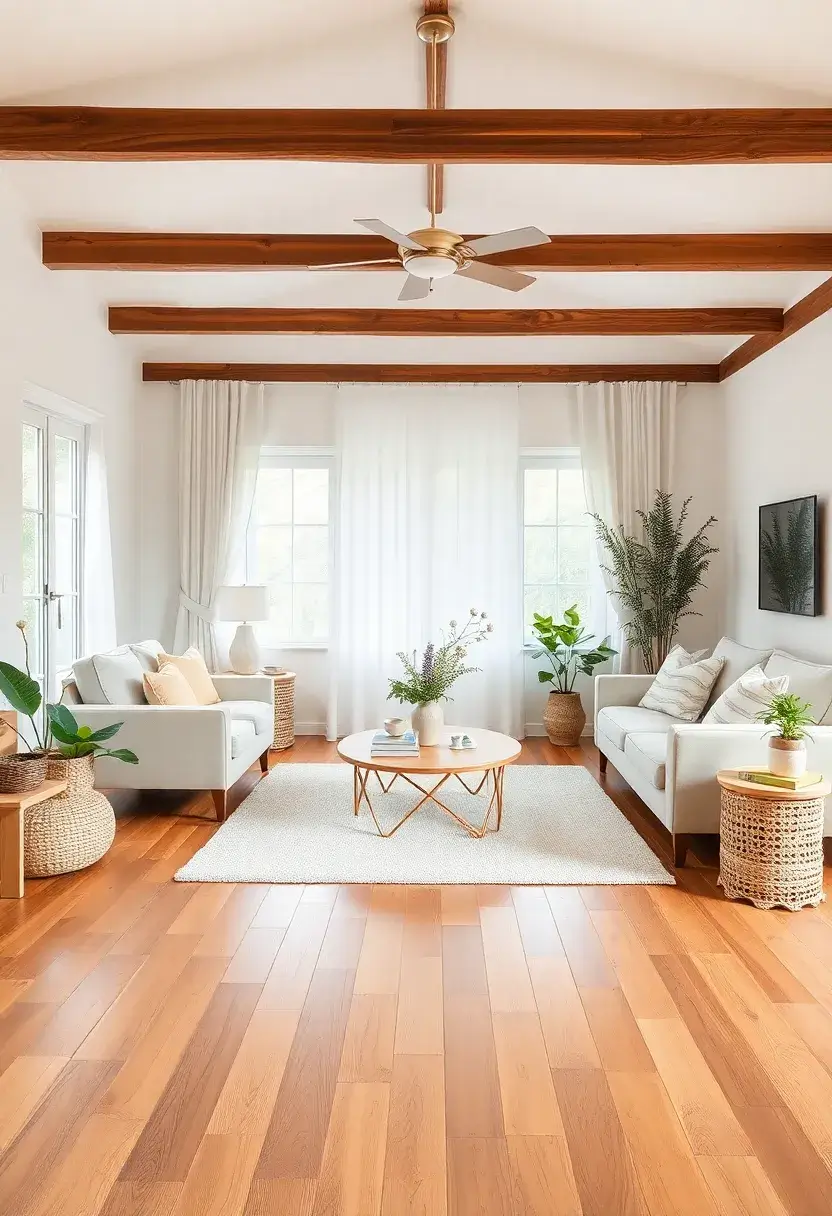
Choosing eco-friendly finishes for hardwood floors ensures a healthier living environment while maintaining style. These finishes are safe for families and pets, free from harmful chemicals. To maintain elegance with eco-friendly finishes, pair them with natural decor elements like plants and organic textiles.
Use light colors in furnishings to create a fresh atmosphere while incorporating minimalistic designs for a clean, modern look. This approach allows you to enjoy beautiful flooring without compromising your health and wellness.
• Pair with natural decor elements like plants
• Use light colors in furnishings for freshness
• Incorporate minimalistic designs for clarity
• Choose eco-friendly textiles for consistency
Eco-friendly finishes create a stylish living room that promotes health and well-being.
Eco-Friendly Finishes for Healthier Living
Editor’s Choice

Quick Shine Multi Surface Floor Finish 64oz | Cleaner & Polish to use on…
 Amazon$10.98
Amazon$10.98
Istana 9×12 Area Rug – Grey 9 x 12 Area Rugs for Living Room – Foldable …
 Amazon$147.99
Amazon$147.99
Costa Farms Live Plants (Pack of 6), Easy to Grow Live Indoor Houseplant…
 Amazon$38.99
Amazon$38.9921. Colorful Staining for Personal Flair
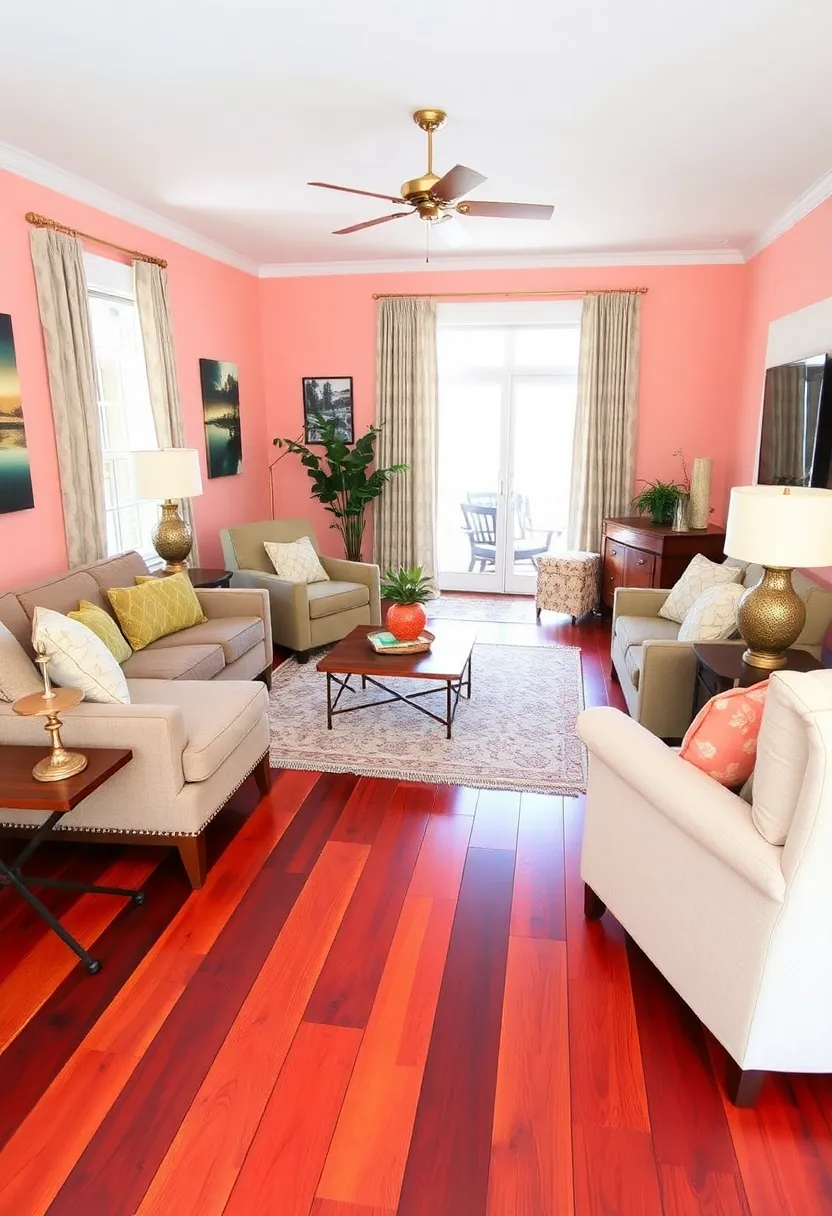
Colorful staining on hardwood floors offers a fun way to express your personality while maintaining the elegance of the wood. This bold choice can elevate your living room’s overall design. To effectively style colorful stains, choose complementary colors for furniture to enhance the flooring.
Use neutral textiles to balance the vibrant hues and incorporate art pieces that echo the floor colors for a cohesive look. This approach breathes life into your living space, showcasing your individuality.
• Choose complementary colors for furniture
• Use neutral textiles for balance
• Incorporate art pieces that echo floor colors
• Keep decor cohesive for harmony
Colorful staining can add a lively and personal touch to your living room, making it uniquely yours.
Did you know colorful stains on hardwood floors can boost warmth in a living room by up to 30%? Pair them with neutral textiles and complementary furniture to keep the space balanced, enhancing your hardwood floor ideas for living room.
Colorful Staining for Personal Flair
Editor’s Choice

Varathane 368035 Less Mess Wood Stain and Applicator, 4 oz, Golden Oak
 Amazon$8.98
Amazon$8.98
6×9 Beige Washable Neutral Area Rug Living Room Floral Non Slip Low Pile…
 Amazon$89.99
Amazon$89.99
97 Decor Vintage Eclectic Wall Art Collage – Abstract Modern Art Prints …
 Amazon$9.99
Amazon$9.9922. Floating Floors for Easy Installation

Floating hardwood floors are an excellent choice for those seeking easy installation while achieving the beauty of hardwood. These floors can be laid over existing flooring, perfect for DIY enthusiasts looking for a quick upgrade. To style floating floors, choose decor that complements the wood’s natural beauty.
Use soft, inviting colors for a welcoming atmosphere while incorporating layered lighting to enhance the space’s warmth. This practical choice allows you to enjoy beautiful flooring without sacrificing style.
• Choose decor that complements the flooring
• Use soft colors for inviting warmth
• Incorporate layered lighting for ambiance
• Keep decor simple to highlight the floors
Floating floors can provide a stylish and practical solution for your living room, making it an inviting space for everyone.
Floating Floors for Easy Installation
Editor’s Choice

Laminate Flooring Tools, NAACOO LVP Installation Kit, Professional Vinyl…
 Amazon$27.99
Amazon$27.99
luckystyle Dimmable Floor Standing Tall Lamp, 12W Led Bulb with Lampshad…
 Amazon$29.99
Amazon$29.99
Lahome Modern Abstract Washable 5×7 Area Rugs for Living Room, Colorful …
 Amazon$47.99
Amazon$47.9923. Matte Finish for Subtle Elegance

A matte finish on hardwood floors offers subtle elegance that enhances your living room. This finish minimizes glare and highlights the wood’s natural texture, creating a warm ambiance. To enhance matte floors, incorporate rich fabrics that invite warmth into the space.
Use warm color schemes in furnishings to complement the wood while keeping decor minimal to let the flooring shine. This approach creates a relaxing environment in your living space, perfect for unwinding after a long day.
• Incorporate rich fabrics for warmth
• Use warm color schemes in furnishings
• Keep decor minimal to highlight flooring
• Choose simple accents for elegance
Matte finishes can create a cozy living room that feels inviting and sophisticated.
Matte Finish for Subtle Elegance
Editor’s Choice

Washable Rugs 8×10 Area Rugs for Living Room,Ultra Soft Faux Wool Retro …
 Amazon$89.99
Amazon$89.99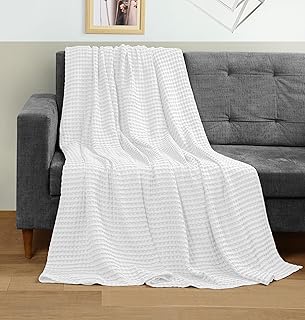
Utopia Bedding White 100% Cotton Waffle Blanket 300 GSM [Throw – 60×50 I…
 Amazon$14.95
Amazon$14.9524. High Gloss Finish for Modern Appeal
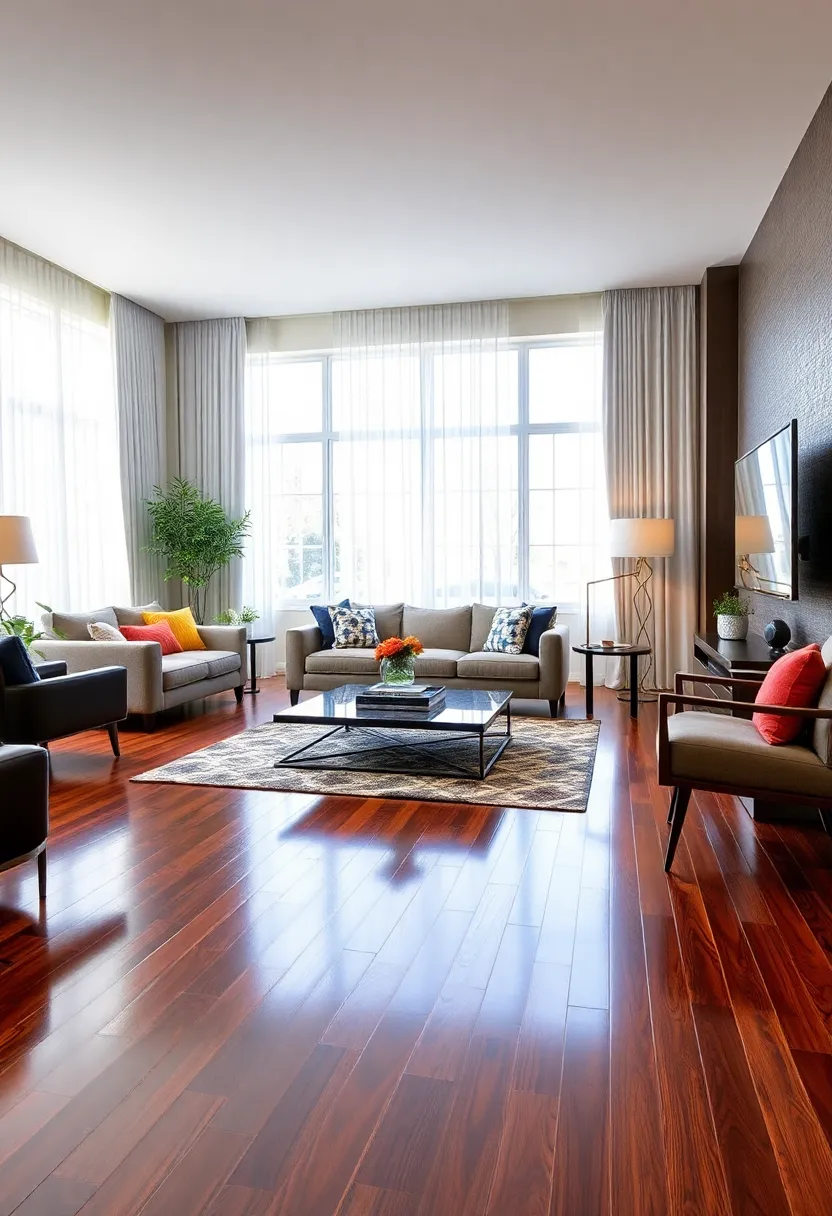
For those who love a sleek, modern look, high gloss hardwood flooring can make a striking statement. The shiny finish reflects light beautifully, enhancing the overall brightness of your living room. To style high gloss floors, use bold, contemporary furniture that complements the shine.
Incorporate colorful accents for a lively feel while adding ample lighting to highlight the glossy finish. This approach elevates your living room into a modern masterpiece, blending elegance with contemporary design.
• Use bold contemporary furniture for style
• Incorporate colorful accents for liveliness
• Add ample lighting to enhance gloss
• Keep decor simple to let flooring shine
High gloss finishes can transform your living room into a stunning, modern space that feels fresh and exciting.
High Gloss Finish for Modern Appeal
Editor’s Choice

Armen Living Jaguar Dining Chair in Charcoal Fabric and Walnut Wood Fini…
 Amazon$97.77
Amazon$97.77
Multicolored Rainbow Abstract Throw Pillow Covers 18×18 in Set of 2, Dec…
 Amazon$9.99
Amazon$9.99
SUNMORY Floor Lamps for Living Room, 32W/3000LM Super Bright LED Floor L…
 Amazon$40.99
Amazon$40.9925. Eco-Conscious Choices for Sustainable Living
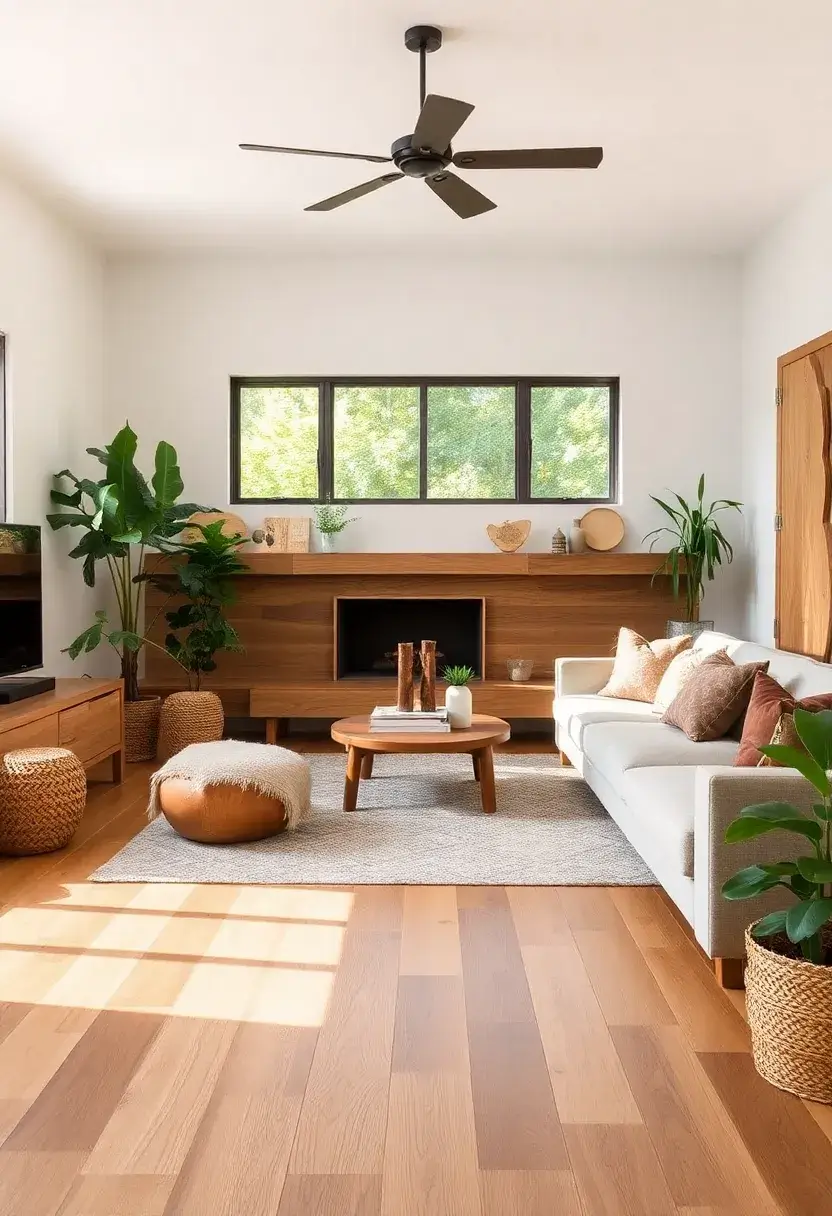
Finally, choosing eco-conscious options for hardwood flooring can contribute to a healthier planet while enhancing your home’s aesthetic. Selecting locally sourced woods reduces your carbon footprint and supports sustainable practices. Look for certifications like FSC (Forest Stewardship Council) to ensure responsible harvesting.
Incorporate recycled materials and finishes to minimize environmental impact while creating a stylish living space. This approach allows you to enjoy beautiful flooring that reflects your commitment to sustainability.
• Choose locally sourced woods for sustainability
• Look for FSC certifications in woods
• Incorporate recycled materials for impact
• Select eco-friendly finishes for consistency
Eco-conscious choices can help you create a beautiful living room that aligns with your values and promotes a healthier environment.
Eco-Conscious Choices for Sustainable Living
Editor’s Choice
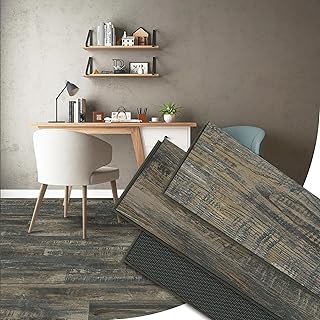
23.9 Sq.Ft SPC Vinyl Flooring Plank Click‑Lock Rigid Core Waterproof Oak…
 Amazon$74.99
Amazon$74.99
FOREVER BAMBOO Bamboo Booster Oil Finish Seal Exclusive Formula UV-Prote…
 Amazon$46.75
Amazon$46.75
Oxdigi Vinyl Flooring Roll 32 sq.ft | 3’4″W x 9’10″L, PVC Leather-Like L…
 Amazon$45.99
Amazon$45.99Conclusion
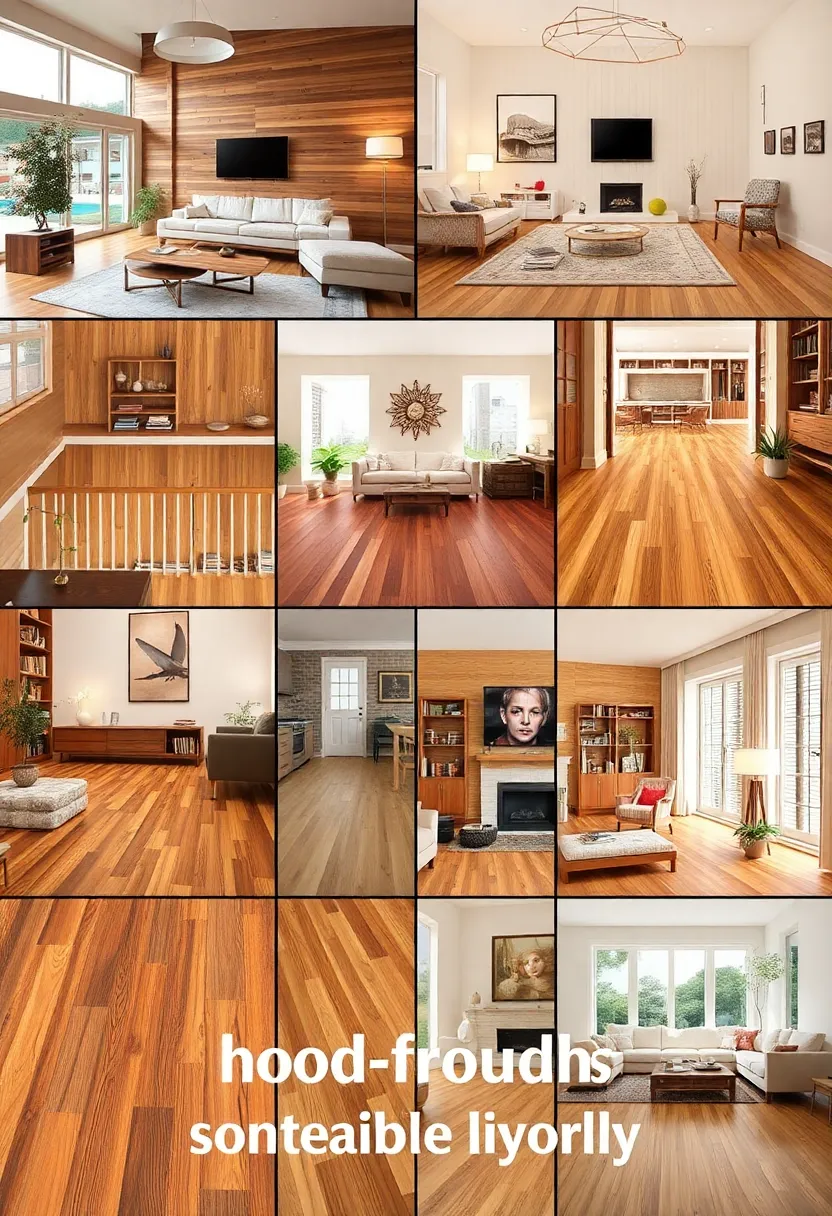
Incorporating hardwood floors into your living room design can elevate the space’s warmth and elegance, especially when selecting sustainable options.
With over 25 unique hardwood floor ideas, you now have plenty of inspiration to create a cozy yet stylish atmosphere that aligns with eco-friendly living.
Consider these options as you design your ideal living room, and enjoy the beauty of hardwood while caring for the planet.
Note: We aim to provide accurate product links, but some may occasionally expire or become unavailable. If this happens, please search directly on Amazon for the product or a suitable alternative.
This post contains Amazon affiliate links, meaning we may earn a small commission if you purchase through our links, at no extra cost to you.
Frequently Asked Questions
What are some sustainable hardwood flooring options for my living room?
If you’re looking to combine elegance with eco-friendliness, consider options like bamboo or reclaimed wood. Bamboo is a fast-growing grass that offers durability and a sleek look, while reclaimed wood adds character and history to your living room. These sustainable hardwood flooring options not only enhance your living room aesthetics but also help reduce environmental impact.
How can I choose the right color scheme for my hardwood floors?
When selecting a color scheme for your hardwood floors, think about the overall vibe you want to create. Lighter woods like maple and ash can make a space feel airy and open, while darker woods such as walnut or mahogany add warmth and sophistication. Consider pairing your flooring with complementary wall colors and decor to enhance the cozy interior ideas you have in mind!
What hardwood flooring designs work best for a cozy living room?
To achieve a cozy atmosphere, consider designs that feature wide planks or distressed finishes. These styles evoke a rustic charm and can make your living room feel more inviting. You can also incorporate area rugs to add texture and warmth, complementing the elegance of your hardwood floors beautifully.
How do I maintain my hardwood floors for long-lasting beauty?
Maintaining your hardwood floors is key to preserving their beauty. Regularly sweep or vacuum to remove dirt and debris, and use a damp mop with a gentle cleaner specifically designed for hardwood. Avoid excess water, as it can damage the wood. Additionally, consider refinishing your floors every few years to keep them looking their best while enhancing the elegant home decor you’ve created.
What are the benefits of using hardwood floors in eco-friendly living rooms?
Hardwood floors offer several benefits for your eco-friendly living room. They are made from renewable resources and can last a lifetime with proper care, reducing the need for replacements. Additionally, hardwood contributes to better indoor air quality as it doesn’t harbor allergens like carpets do. This makes it a great choice for creating a healthy, cozy interior that aligns with sustainable living principles!
Related Topics
home decor
hardwood flooring
living room aesthetics
eco-friendly design
cozy interiors
elegant style
flooring color schemes
sustainable options
modern elegance
DIY flooring
warmth and comfort
trending decor

